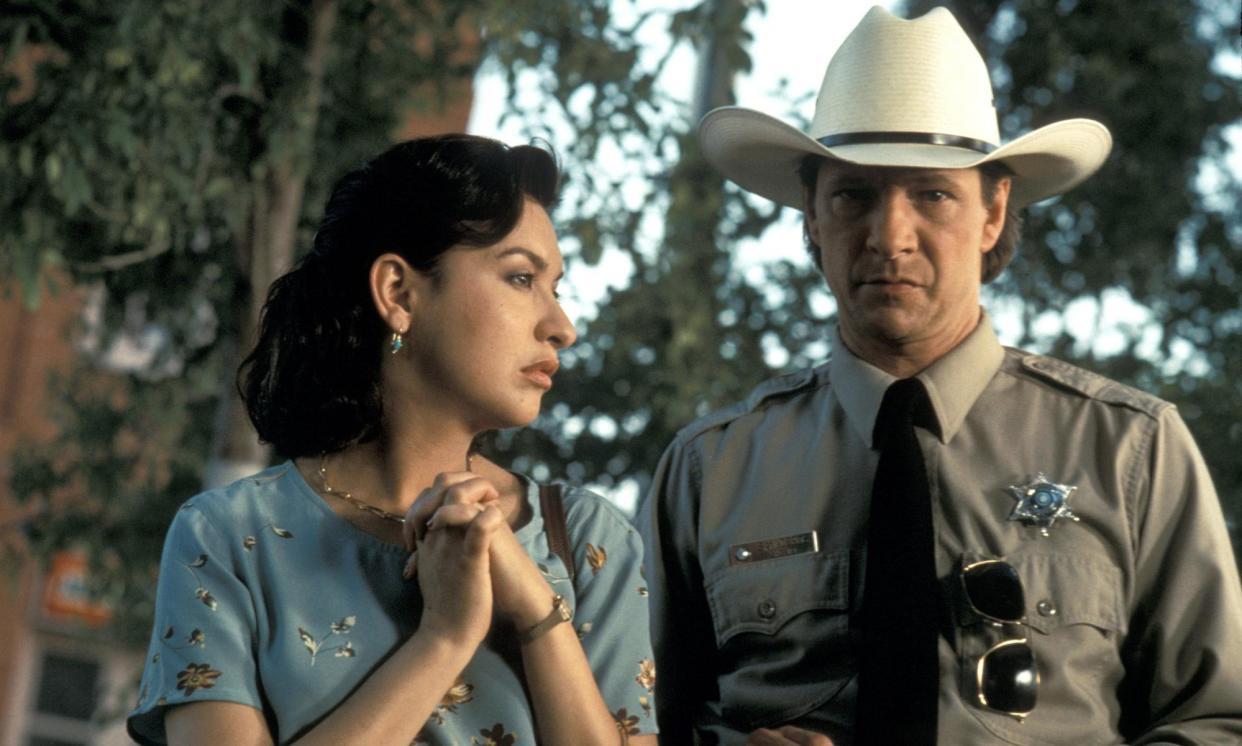‘I recently went back to the Texas border – and urinated on the wall’: how we made Lone Star

John Sayles, writer and director
We decided to make a film about the Texas border after going there in 1978 to shoot a cameo in the Joe Dante film Piranha, which I wrote. On my day off, I visited the Alamo in San Antonio. What I knew about the battle was mostly the Walt Disney version – Davy Crockett and all that. But the day I was there, Chicano-Americans were protesting, saying: “Tell the whole story.” I got interested in its racial complexity, the fact there were Mexicans fighting for the US, too, and that the “freedom” the Texans were fighting for was the freedom to own slaves. That’s a major part that gets left out.
The kind of story Lone Star tells – about the fate of white racist sheriff Charlie Wade, played by Kris Kristofferson – isn’t that uncommon. A person has a reign with an inordinate amount of power. My script had elements of a western, but it was more of a detective story. It was one of those rare instances where I wrote it and we got the money to make it right away.
I cast Chris Cooper as the present-day sheriff investigating Wade’s murder because he had that iconic American Gary Cooper thing. One thing he can do very well is play a subtext, which was needed in interrogation scenes. In those, he is essentially asking: what kind of man was my father, the sheriff who challenged and replaced Wade? It’s not easy to get the performance right when you’re shooting out of sequence. Chris constantly had to ask himself where his character was in the mystery story and what he was feeling.
The border patrol would just say ‘No me hagas correr’ to illegal immigrants – ‘Don’t make me run’ – and deport them
I never do rehearsals – I want the shock of the new. Matthew McConaughey, who plays Chris’s father Buddy, had only done one movie before: Richard Linklater’s Dazed and Confused. I needed a guy who didn’t have any star weight but who had the presence to play off against Kristofferson.
I didn’t want normal cuts between present and past, so I did a lot of live transitions, which were a lot of fun for the crew to figure out. In the first one – where the camera starts on a basket of tortillas as we switch from the present into Kristofferson’s timeline – Clifton James, the old character actor narrating the story, couldn’t get out of shot quickly enough. So the grips had to pick him up in his chair and get him out of the way to be replaced by Matthew in the past. Doing those seamless transitions gave the sense that these characters all carry their history around with them.
I don’t think we’ve made any progress on border issues since the movie was made. Back then, it didn’t have the same tension. The border patrol would just say no me hagas correr to illegal immigrants – don’t make me run – and deport them. I don’t think a wall is the answer: it’s like a Christo installation that has cost billions of dollars. I recently visited it with a friend and we urinated on it.
Chris Cooper, actor
John first told me the story over dinner with his partner, the film’s producer Maggie Renzi. Only at the end did I realise he wanted me to play Sam Deeds, the present-day sheriff, which knocked me off my chair. He used this word for him: “laconic”. I said: “Why does he have to be laconic?” John eventually said: “I wrote this for you, because you’re laconic.” It took me a little while to go with it.
The script was across-the-tables, one-on-one, human-to-human, which is what I thrive on. We didn’t have that green-screen nonsense back then. John does something few other directors do: he gives you a couple of pages of character background – a great springboard for getting on the same track as him. But I was already extremely familiar with Texas. Everyone on both sides of my family is Texan going back generations.
For Sam and his father Buddy, I drew on memories of my relationship with my father. We loved each other, but had our ups and downs. He was very conservative, and we were at opposite extremes politically. He thought acting was the silliest thing a person could do. Him being a doctor, he’d say: “You want to see drama?” And he’d take me to the emergency room.
I didn’t realise the transgressive nature of what was happening between me and Pilar, the schoolteacher played by Elizabeth Peña, until my second read-through. Maggie said to me: “Their dance scene and the love scene afterwards have to work.” Elizabeth and I fell back on to the bed, and John shot us from the chest up. The selling point for Maggie was when I reached over and played with Elizabeth’s hair and tickled her ear. It was the kind of thing I do with my wife.
John is 20 years ahead in his storytelling. Look at what we’re dealing with now. Border conflict is a nightmare. The way John did those transitions suggests history is never too far away from the present. That’s the film’s legacy: things don’t change too quickly, if ever.
• Lone Star is out on Criterion Collection 4K UHD and Blu-ray and is available on streaming services

 Yahoo Movies
Yahoo Movies 
